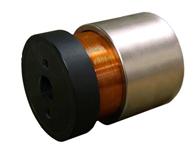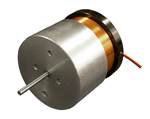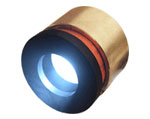
|
|
Voice Coil Motors
|
|
|
 |
 |
 |
| |
|
|
|
 |
|
Linear Voice Coil Motors
Linear DC Motors, Voice
Coil Motors (VCM) or Voice Coil Actuators (VCA) are the simplest type of
electric motors. These motors consist of two separate parts; the
magnetic housing and the coil.
Applying a voltage
across the terminals of the motor causes the motor to move to one
direction. Reversing the polarity of the applied voltage will move the
motor to the opposite direction. The generated
force is proportional to the current that
flows through the motor coil. This force is almost constant in the
specified stroke range of the motor.
Voice coil motors do
not need commutation and using a position sensor, positioning accuracies
of less than one micron or 0.00004 inches are achievable.
|
|
|
|
 |
|
Linear Voice Coil Motors with Internal Bearing
Linear DC Motors, Voice
Coil Motors (VCM) or Voice Coil Actuators (VCA) are the simplest type of
electric motors. These motors consist of two separate parts; the
magnetic housing and the coil.
Applying a voltage
across the terminals of the motor causes the motor to move to one
direction. Reversing the polarity of the applied voltage will move the
motor to the opposite direction. The generated
force is proportional to the current that
flows through the motor coil. This force is almost constant in the
specified stroke range of the motor.
Voice coil motors do
not need commutation and using a position sensor, positioning accuracies
of less than one micron or 0.00004 inches are achievable.
|
|
|
|
 |
|
Hollow Core Linear Voice Coil Motors
These
motors, having a large axial hole throughout the entire coil and body
structure are ideal
for optical focusing, scanning and other precision positioning
applications.
Linear DC Motors, Voice Coil Motors (VCM) or Voice Coil Actuators (VCA)
are the simplest type of electric motors. These motors consist of two
separate parts; the magnetic housing and the coil. Applying a voltage
across the terminals of the motor causes the motor to move to one
direction. Reversing the polarity of the applied voltage will move the
motor to the opposite direction. The generated force is proportional to
the current that flows through the motor coil. This force is almost
constant in the specified stroke range of the motor.
Voice coil motors do
not need commutation and using a position sensor, positioning accuracies
of less than one micron or 0.00004 inches are achievable.
|
| | |